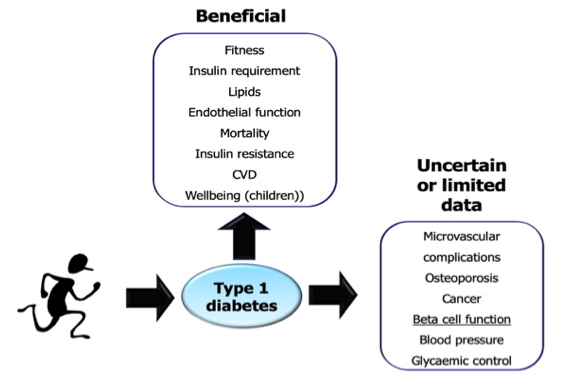 Advice for Professionals
Advice for Professionals

The benefits of exercise for people with Type 1 diabetes
Regular physical activity (PA) plays a key role in the management of Type 1 diabetes mellitus (T1D). This has been known for years as on the Joslin Victory Medal it is one of the three horses that controls Type 1 diabetes, the other being Insulin and diet. |  |
Figure 1: Joslin Victory medal for living with T1DM | |
Figure 2 summaries what is known about the benefits of exercise in people with T1D . The known benefits include
- improved insulin sensitivity
- improved well-being
- reduction in lipids
- reduction in microvascular complications
- reduced mortality
For further information see What are the health benefits of physical activity in type 1 diabetes mellitus? A literature review
Figure 2: Summary of health benefits of regular exercise in Type 1 diabetes.

Although there is as yet not conclusive evidence that regular exercise helps to preserve beta cell function there is some evidence to support this
- In mice susceptible to diabetes (NOD mouse) regular exercise prevents the development of diabetes. See Exercise Training but not Curcumin Supplementation Decreases Immune Cell Infiltration in the Pancreatic Islets of a Genetically Susceptible Model of Type 1 Diabetes
- The Type 1 diabetes honeymoon period is more than five times longer in men undertaking high levels of physical exercise, compared with age‐, sex‐ and BMI‐matched sedentary controls. See The Type 1 diabetes ‘honeymoon’ period is five times longer in men who exercise: a case–control study
- In a pilot RCT of newly diagnosed patients with Type 1 diabetes there is some suggestion that exercise preserves beta cell function. See Exercise to preserve β‐cell function in recent‐onset Type 1 diabetes mellitus (EXTOD) – a randomized controlled pilot trial
Note that improvement in HbA1c is not listed as one of the benefits of exercise. A meta-analysis of studies carried out in 2013 by us did not demonstrate an improvement in HbA1c with regular exercise in adults and children with Type 1 diabetes. For more information about this see Does exercise improve glycaemic control in type 1 diabetes? A systematic review and meta-analysis
One reason for this could be that advice given to people with Type 1 diabetes around how to control glucose around exercise is not very good.
Recommended Levels of activity for people with Type 1 diabetes and barriers to exercise
Based on this evidence guidelines recommend that adults with Type 1 diabetes undertake at least 150 min per week of moderate to vigorous aerobic exercise, spread out over at least 3 days, with no more than two consecutive days between bouts of aerobic activity (see Physical Activity/Exercise and Diabetes: A Position Statement of the American Diabetes Association and Physical activity levels of people with Type 1 diabetes section of this website.
Over 70% of people with Type 1 diabetes do not meet these recommendations and thus are not getting the full benefits they could do from exercise. (See Physical activity levels of people with Type 1 diabetes section of this website to learn more about recommended levels of activity for people with Type 1 diabetes and current activity levels of people with Type 1 diabetes.)
Reported barriers to exercise in those with Type 1 diabetes include fear of hypoglycaemia, competing work commitments, loss of control over diabetes, low fitness levels, cost, lack of social support, and lack of knowledge. Greater knowledge about insulin pharmacokinetics and using appropriate approaches to minimise exercise‐induced hypoglycaemia or hyperglycaemia are factors associated with fewer perceived barriers to exercise (see Barriers to exercise in people with Type 1 diabetes section of the this website to learn more about barriers in Type 1 diabetes).This suggests that the provision of knowledge and skills is essential if we are to support people with Type 1 diabetes to become more active and enable them to exercise safely at the level they wish to.
Other parts of the website should help you to arm your patients with knowledge to overcome these barriers.
Articles linked to this article
